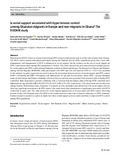UGSpace Repository
Total Serum Magnesium Levels and Calcium-To-Magnesium Ratio in Sickle Cell Disease
JavaScript is disabled for your browser. Some features of this site may not work without it.
| dc.contributor.author | Antwi-Boasiako, C. | |
| dc.contributor.author | Kusi-Mensah, Y.A. | |
| dc.contributor.author | Hayfron-Benjamin, C. | |
| dc.contributor.author | Aryee, R. | |
| dc.contributor.author | Dankwah, G.B. | |
| dc.contributor.author | Kwawukume, L.A. | |
| dc.contributor.author | Darkwa, E.O. | |
| dc.date.accessioned | 2019-09-27T15:38:30Z | |
| dc.date.available | 2019-09-27T15:38:30Z | |
| dc.date.issued | 2019-08-27 | |
| dc.identifier.other | doi:10.3390/medicina55090547 | |
| dc.identifier.uri | http://ugspace.ug.edu.gh/handle/123456789/32332 | |
| dc.description | Research Article | en_US |
| dc.description.abstract | Background and Objectives: Imbalance of calcium/magnesium ratio could lead to clinical complications in sickle cell disease (SCD). Low levels of magnesium have been associated with sickling, increased polymerization and vaso-occlusion (VOC) in sickle cell due to cell dehydration. The K-Cl cotransport plays a very important role in sickle cell dehydration and is inhibited by significantly increasing levels of magnesium. The study evaluated total serum magnesium levels and computed calcium/magnesium ratio in SCD patients and “healthy” controls. Materials and Methods: The study was a case-control cross-sectional one, involving 120 SCD patients (79 Haemoglobin SS (HbSS)and 41 Haemoglobin SC (HbSC)) at the steady state and 48 “healthy” controls. Sera were prepared from whole blood samples (n = 168) and total magnesium and calcium measured using a Flame Atomic Absorption Spectrometer (Variant 240FS manufactured by VARIAN Australia Pty Ltd., Melbourne, VIC, Australia). Calcium/magnesium ratios were calculated in patients and the controls. Results: The prevalence of hypomagnesemia and hypocalcaemia among the SCD patients was observed to be 39.17% and 52.50% respectively, higher than the controls (4.17% and 22.92%, for hypomagnesemia and hypocalcaemia, respectively). Level of magnesium was significantly lower in the SCD patients compared to their healthy counterparts (p = 0.002). The magnesium level was further reduced in the HbSS patients but not significantly di erent from the HbSC patients (p = 0.584). calcium/magnesium ratio was significantly higher in the SCD patients (p = 0.031). Although calcium/magnesium ratio was higher in the HbSC patients compared to those with the HbSS genotype, the di erence was not significant (p = 0.101). Conclusion: The study shows that magnesium homeostasis are altered in SCD patients, and their levels are lower in HbSS patients. Although calcium/magnesium ratio is significantly higher in SCD patients compared with controls, there is no significant di erence between patients with HbSS and HbSC genotypes. Magnesium supplementation may be required in sickle cell patients. | en_US |
| dc.language.iso | en | en_US |
| dc.publisher | Medicina | en_US |
| dc.relation.ispartofseries | 55;9 | |
| dc.subject | Magnesium | en_US |
| dc.subject | Calcium | en_US |
| dc.subject | Homeostasis | en_US |
| dc.subject | Cell dehydration | en_US |
| dc.subject | Sickle cell disease | en_US |
| dc.title | Total Serum Magnesium Levels and Calcium-To-Magnesium Ratio in Sickle Cell Disease | en_US |
| dc.type | Article | en_US |
